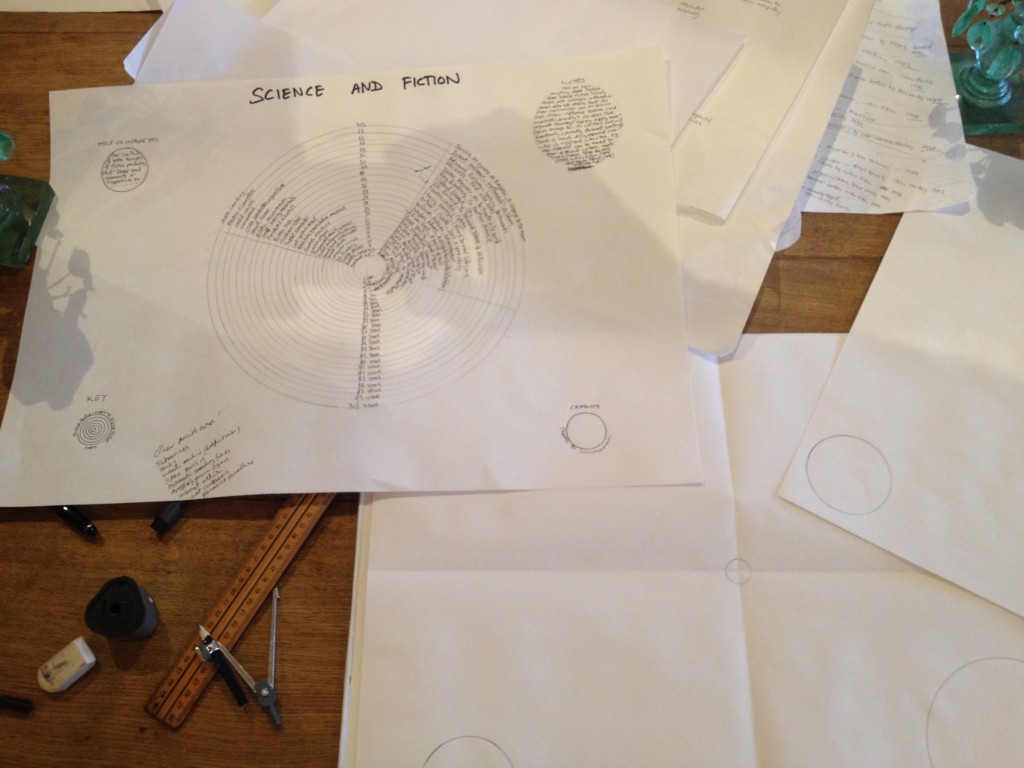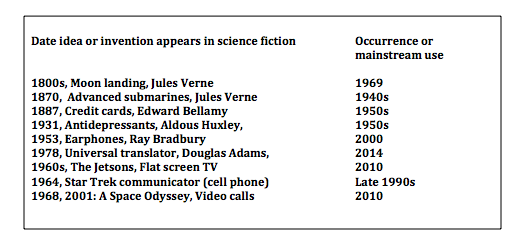The first intimations of the cyborg, for me, were the robots in a 1940 Republic serial called THE MYSTERIOUS DR. SATAN. These robots had been recycled from the earlier UNDERSEA KINGDOM, 1936, and would appear again in the brilliantly-titled ZOMBIES OF THE STRATOSPHERE, 1952. I have those dates and titles not because I’m any sort of expert on Republic serials, or even on science fiction in general, but because I’ve bookmarked Google. But we’ll get back to Google later.
THE MYSTERIOUS DR. SATAN was among my earliest cinematic experiences. I probably saw it in 1952, and I definitely saw it on a television whose cabinet was made out of actual wood, something that strikes me today as wholly fantastic. These Republic cliffhangers, made originally for theatrical release, one episode at a time, were recycled in the Fifties for local broadcast in the after-school slot, after half an hour of black and white Hollywood cartoons.
I can remember being utterly terrified by Dr. Satan’s robots, which had massive tubular bodies, no shoulders, hands like giant Visegrip pliers, and limbs made of some sort of flexible metal tubing. They had been on the job since 1936, which contributed strongly to the weirdness of their design-language, but I had no way of knowing that. I just knew that they were the scariest thing I’d ever seen, ever, and I could barely stand to watch them menace the hero or his girlfriend.
I wonder now what I knew about robots. That they were called “robots”, and were “mechanical men”. That these particular robots were the servants of Dr. Satan. Did I believe that they were autonomous, or that Dr. Satan controlled them? Probably the latter, as menacing-robot scenes in serials of this sort often involved a sort of telepresence, and the suggest of remote control. Cut from robot, menacing, to evil scientist in his lab, watching robot menace on television screen. Evil scientist closes giant knife-switch, which causes robot to menace even harder.
Given that I was watching this material in the early Fifties, I would shortly become familiar with the expression “electronic brain”, which like “rocket ship” was there as a marker of something anticipated but not yet here. Actually, it already was here, and had been since World War II, but most people didn’t know it yet. And that is where postwar science fiction, in retrospect, got it most broadly wrong: all eyes were on the rocket ship, relatively few on the electronic brain. We all know, today, which one’s had the greater impact.
An electronic brain. What would you do with one of those, if you had one? In 1940, you’d probably stick it in a machine of some kind. Not one of Dr. Satan’s recycled Atlantean robots, but something practical. Say a machine that could weld leaf-springs in a Milwaukee tractor factory.
This, really, is about what science fiction writers call “Steam Engine Time”. The observable fact that steam, contained, exerts force, has been around since the first lid rattled as the soup came to a boil. The ancient Greeks built toy steam engines that whirled brass globes. But you won’t get a locomotive ‘til it’s Steam Engine Time.
What you wouldn’t do, in 1940, with an electronic brain, would be to stick it on your desk, connect it somehow to a typewriter, and, if you, had one, a television of the sort demonstrated at the 1939 Worlds fair in New York. At which point it would start to resemble… But it’s not Steam Engine Time yet, so you can’t do that. Although you would, or anyway you’d think about it, if you were a man named Vannevar Bush, but we’ll come back to him later. Vannevar Bush almost single-handedly invented what we now think of as the military-industrial complex. He did that for Franklin Roosevelt, but it isn’t what he’ll be remembered for.
I can’t remember a robot ever scaring me that much, after DR. SATAN’s robots. They continued to be part of the cultural baggage of sf, but generally seemed rather neutral, at least to me. Good or bad depending on who was employing them in a given narrative. Isaac Asimov wrote a whole shelf of novels working out a set of hard-wired ethics for intelligent robots, but I never got into them. The tin guys didn’t, by the Sixties, seem to me to be what was interesting in science fiction, and neither did space ships. It was what made Asimov’s robots intelligent in the first place that would have interested me, had I thought of it, but I didn’t.
What interested me most in the sf of the 60s was the investigation of the politics of perception, some of which, I imagine, could now be seen in retrospect as having been approached through various and variously evolving ideas of the cyborg. Stories about intelligent rocket ships and how humans might interact with them, or stories of humans forced through circumstances to become the non-electronic brain in an otherwise traditional robot. A sort of projection was underway, an exploration of boundaries. And meanwhile, out in the world, the cyborg was arriving. Or continuing to arrive.
Though not in science fiction’s sense of the cyborg, which was that of a literal and specific human-machine hybrid. There’s a species of literalism in our civilization that tends to infect science fiction as well: it’s easier to depict the union of human and machine literally, close-up on the cranial jack please, than to describe the true and daily and largely invisible nature of an all-encompassing embrace
The real cyborg, cybernetic organism in the broader sense, had been busy arriving as I watched DR. SATAN on that wooden television in 1952. I was becoming a part of something, in the act of watching that screen. We all were. We are today. The human species was already in process of growing itself an extended communal nervous system, then, and was doing things with it that had previously been impossible: viewing things at a distance, viewing things that had happened in the past, watching dead men talk and hearing their words. What had been absolute limits of the experiential world had in a very real and literal way been profoundly and amazingly altered, extended, changed. And would continue to be. And the real marvel of this was how utterly we took it all for granted.
Science fiction’s cyborg was a literal chimera of meat and machine. The world’s cyborg was an extended human nervous system: film, radio, broadcast television, and a shift in perception so profound that I believe we’re yet to understand it. Watching television, we each became aspects of an electronic brain. We became augmented. In the Eighties, when Virtual Reality was the buzzword, we were presented with images of…television! If the content is sufficiently engrossing, however, you don’t need wraparound deep-immersion goggles to shut out the world. You grow your own. You are there. Watching the content you most want to see, you see nothing else.
The physical union of human and machine, long dreaded and long anticipated, has been an accomplished fact for decades, though we tend not to see it. We tend not to see it because we are it, and because we still employ Newtonian paradigms that tell us that “physical” has only to do with what we can see, or touch. Which of course is not the case. The electrons streaming into a child’s eye from the screen of the wooden television are as physical as anything else. As physical as the neurons subsequently moving along that child’s optic nerves. As physical as the structures and chemicals those neurons will encounter in the human brain. We are implicit, here, all of us, in a vast physical construct of artificially linked nervous systems. Invisible. We cannot touch it.
We are it. We are already the Borg, but we seem to need myth to bring us to that knowledge.
Steam Engine Time. Somewhere in the late Seventies. In garages, in California. Putting the electronic brain on the table. Doing an end run around Dr. Asimov’s ethical robots. The arms and legs, should you require them, are mere peripherals. To any informed contemporary child, a robot is simply a computer being carried around by its peripherals. Actually I think this accounts for the generally poor sales of several recent generations of commercial humanoid robots; they’re all more than a little embarrassing, at some level. Sony’s Aibo, a robot dog, does slightly better in the market. Who today wouldn’t simply prefer to have a faster and more powerful computer, faster internet access? That’s where the action is. That augmentation. Of the user. Of us.
Actually the return of those humanoid robots has disappointed me. I’d thought that everyone had gotten it: that you don’t need to go anthropocentric in order to get work done. That in fact you get less work done, far less bang for your buck, if you do. My idea of an efficient robot today would be an American Predator drone with Hellfire missiles, or one of the fly-sized equivalents allegedly on Pentagon CAD-CAM screens if not already in the field. Though actually those are both cyborgs, or borg-aspects, as they are capable both of autonomous actions and actions via telepresent control. When the human operator uplinks, operator and Predator constitute a cyborg. Bruce Sterling wrote a short story, in the early Eighties, in which the protagonists were the Soviet equivalents of Predator drones, but literal cyborgs: small fighter aircraft controlled by brain-in-bottle on-board pilots, with very little left in the way of bodies. But why, today, bother building those (unless of course to provide the thrill of piloting to someone who might otherwise not experience it, which would be a worthy goal in my view). But for purely military purposes, without that live meat on board, aircraft are capable of executing maneuvers at speeds that would kill a human being. The next generation of US fighter aircraft, for this and other tactical reasons, will almost certainly be physically unmanned.
Martian jet lag. That’s what you get when you operate one of those little Radio Shack wagon/probes from a comfortable seat back at an airbase in California. Literally. Those operators were the first humans to experience Martian jet lag. In my sense of things, we should know their names: first humans on the Red Planet. Robbed of recognition by that same old school of human literalism.
This is the sort of thing that science fiction, traditionally, is neither good at predicting, nor, should we predict it, at describing.
Vannever Bush, who I mentioned earlier, was not a science fiction writer. In World War II he was chief scientific adviser to Franklin Roosevelt, and director of the Office of Scientific Research and Development, where he supervised the work that led to the creation of the atomic bomb. He more or less invented the military-industrial complex, as we call it today. In 1945 he published an article in the ATLANTIC MONTHLY titled “As We May Think”. In this article he imagined a system he called the “memex”, short for “memory extender”. If there was a more eerily prescient piece of prose, fiction or otherwise, written in the first half the 20th Century, I don’t know it.
This article is remembered most often, today, for having first envisioned what we call the principle of “hyperlinking”, a means of connecting disparate but conceptually involved units of data. But I’ve never read it that way, myself. I think Vannevar Bush envisioned the cyborg, in the sense I’ve been suggesting we most valuably use that word.
One remarkable thing about this is that he seemed to have no particular idea that electronics would have anything to do with it. He begins by imagining an engineer, a technocrat figure, equipped with a “walnut-sized” (his phrase) camera, which is strapped to the center of his forehead, it’s shutter operated by a hand-held remote. The technocrat’s glasses are engraved with crosshairs. If he can see it, he can photograph it.
Bush imagines this as a sort of pre-Polaroid microfilm device, “dry photography” he calls it, and he imagines his technocrat snapping away at project-sites, blueprints, documents, as he works.
He then imagines the memex itself, a desk (oak, he actually suggests, reminding me of my television set in 1952) with frosted glass screens inset in its top, on which the user can call up those images previously snapped with that forehead-walnut. Also in the desk are all of the user’s papers, business records, etc., all stored as instantly retrievable microfiche, plus the contents of whole specialized libraries.
At this point, Bush introduces the idea which earns him his place in conventional histories of computing: the idea of somehow marking “trails” through the data, a way of navigating, of being able to backtrack. The hyperlink idea.
But what I see, when I look at Bush’s engineer, with his Polaroid walnut and his frosted-glass, oak-framed desktop, is the cyborg. In both senses. A creature of Augmented rather than Virtual Reality. He is…us! As close to the reality of being us, today, as anyone in 1945 (or perhaps in 1965, for that matter) ever managed to get! Bush didn’t have the technology to put beneath the desktop, so he made do with what he knew, but he’s describing the personal computer. He’s describing, with an accuracy of prediction that still gives me goose-bumps, how these devices with be used. How the user’s memory with be augmented, and connected to whole Borgesian libraries, searchable and waiting. Google! The memex, awaiting the engineer’s search-string!
But in our future, awaiting the interconnectedness of desktops. Awaiting the net. Bush didn’t see that, that we’d link memex’s, and create libraries in common. Steam Engine Time: he couldn’t go there, though he got closer than anyone else, in his day, to getting it.
There’s my cybernetic organism: the internet. If you accept that “physical” isn’t only the things we can touch, it’s the largest man-made object on the planet, or will be, soon: it’s outstripping the telephone system, or ingesting it, as I speak. And we who participate in it are physically a part of it. The Borg we are becoming.
So for me the sci-fi cyborg, the meat/metal hybrid, is already another of those symbols, somewhat in the way that Dr. Satan’s robots had their origin, as symbols, in a Czech satirist’s view of alienated labor. The real deal is that which we already participate in daily, meld with, grow into.
The big news in biology this week was the announcement that we’ve stopped evolving, in the biological sense. I’ll buy that. Technology has stopped us, and technology will take us on, into a new evolution, one Mr. Bush never dreamed of, and neither, I’m sure, have I.
Interface evolves toward transparency. The one you have to devote the least conscious effort to, survives, prospers. This is true for interface hardware as well, so that the cranial jacks and brain inserts and bolts in the neck, all the transitional sci-fi hardware of the sci-fi cyborg, already looks slightly quaint. The real cyborg, the global organism, is so splendidly invasive that these things already seem medieval. They fascinate, much as torture instruments do, or reveal erotic possibilities to the adventurous, or beckon as stages or canvasses for the artist, but I doubt that very many of us will ever go there. The real cyborg will be deeper and more subtle and exist increasingly at the particle level, in a humanity where unaugmented reality will eventually be a hypothetical construct, something we can only try, with great difficulty, to imagine — as we might try, today, to imagine a world without electronic media.




